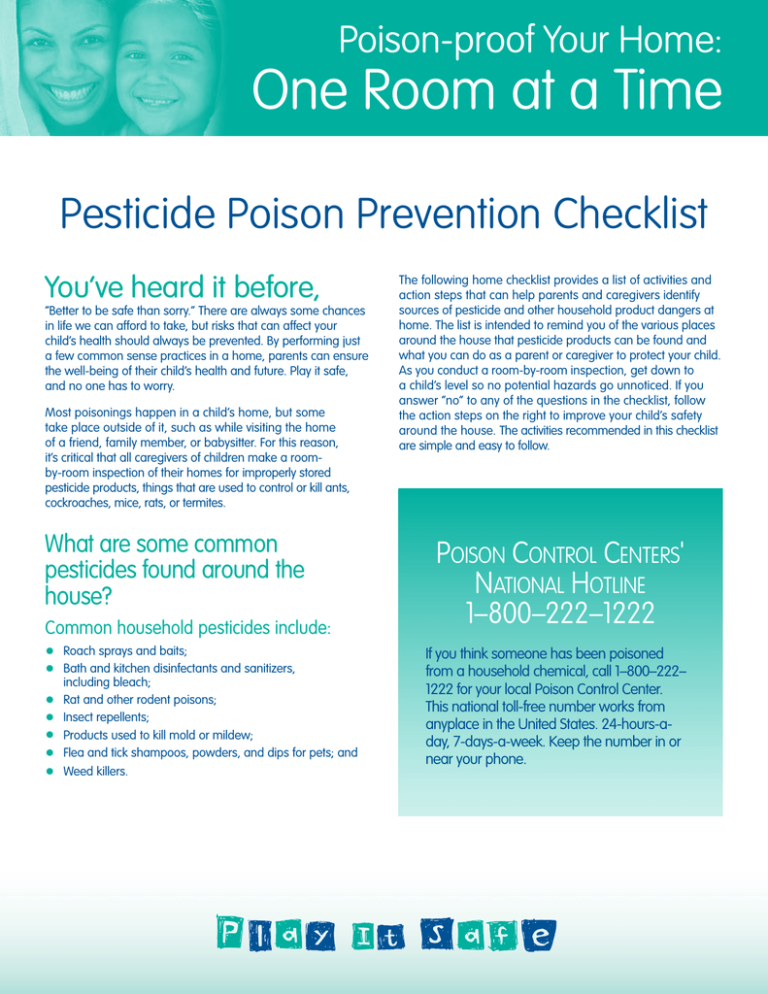One Room at a Time Pesticide Poison Prevention Checklist Poison-proof Your Home:
advertisement

Poison-proof Your Home: One Room at a Time Pesticide Poison Prevention Checklist You’ve heard it before, ”Better to be safe than sorry.” There are always some chances in life we can afford to take, but risks that can affect your child’s health should always be prevented. By performing just a few common sense practices in a home, parents can ensure the well-being of their child’s health and future. Play it safe, and no one has to worry. Most poisonings happen in a child’s home, but some take place outside of it, such as while visiting the home of a friend, family member, or babysitter. For this reason, it’s critical that all caregivers of children make a roomby-room inspection of their homes for improperly stored pesticide products, things that are used to control or kill ants, cockroaches, mice, rats, or termites. What are some common pesticides found around the house? Common household pesticides include: • Roach sprays and baits; • Bath and kitchen disinfectants and sanitizers, • • • • • including bleach; Rat and other rodent poisons; Insect repellents; Products used to kill mold or mildew; Flea and tick shampoos, powders, and dips for pets; and Weed killers. The following home checklist provides a list of activities and action steps that can help parents and caregivers identify sources of pesticide and other household product dangers at home. The list is intended to remind you of the various places around the house that pesticide products can be found and what you can do as a parent or caregiver to protect your child. As you conduct a room-by-room inspection, get down to a child’s level so no potential hazards go unnoticed. If you answer “no” to any of the questions in the checklist, follow the action steps on the right to improve your child’s safety around the house. The activities recommended in this checklist are simple and easy to follow. Poison Control Centers' National Hotline 1–800–222–1222 If you think someone has been poisoned from a household chemical, call 1–800–222– 1222 for your local Poison Control Center. This national toll-free number works from anyplace in the United States. 24-hours-aday, 7-days-a-week. Keep the number in or near your phone. Pesticide Poison Prevention Checklist Questions Action Steps Bathroom Did you inspect the bathroom and move toilet bowl cleaners, medicine, cosmetics, tile cleaners, bathroom deodorizers, mouthwash, and other personal hygiene products out of reach from small children in a high, locked cabinet? Yes No ■ Re-close containers if interrupted during an application (e.g. phone call or doorbell). Make sure all harmful containers are fully sealed and out of a child’s reach during temporary absence. Are all medications and pesticide products, such as bathroom cleansers and mouthwashes, tightly sealed with child-resistant caps? Yes No ■ Read Yes No ■ Mothballs Yes No ■ Did you store hazardous products like bleach, bug spray, drain cleaners, ammonia, floor wax, furniture polish, and disinfectants up high in a locked cabinet? Yes No ■ If Did you store household cleaning products, such as dishwashing detergent, disinfectants, oven and window cleansers, and drain cleaners in a place away from food? Yes No ■ Pesticides Are all kitchen cleanser, drain opener, and ammonia substances in their original containers? Yes No ■ Keep Are all cleaning liquids and medicines properly sealed? Yes No ■ Keep Did you store gasoline, kerosene, car wax and soaps, weed killers, pesticide sprays, paint, windshield washer fluid, and anti-freeze substances up high out of the reach of young children? Yes No ■ Poisonous Have you stored all hazardous fluids and pesticides high in a locked cabinet where children can’t gain access? Yes No ■ Store Are chemicals and laundry detergents or softeners out of the reach of young children? Yes No ■ Using Is the bleach container closed properly? Yes No ■ Keep the Label First. Follow all directions exactly as they are written on the label, including any noted precautions and product restrictions. Bedroom Did you store items like mothballs, cosmetics, hair sprays, colognes, nail polish remover, and medicine products in a locked cabinet away from a child’s reach? should be hung in containers. If such products are used in closets or chests, they should be stored out of children’s reach. Living Room Have you placed all ant or roach baits and rodent pellets out of children’s reach? Place roach and rodent baits in areas where children can not touch them. If possible, place rodent bait in a tamper-resistant bait station. Kitchen items cannot be moved up high, install safety latches on lower cabinets to keep children out. and foods should never be stored on the same shelf as pesticides may be mistaken for food. all substances in their original containers. Using beverage bottles or cans for storing cleaning liquids and other household mixtures is very dangerous and may be mistaken for a drink. Plus, labels on original containers give first-aid information in case of accidental poisoning. potentially hazardous cleaning products and medicines properly closed while using, even if a container is briefly left unattended. Garage anti-freeze tastes sweet to dogs and cats— clean up spills and leaks immediately. all hazardous fluids and pesticides high in locked cabinets where children can't gain access. Laundry Room bottles and cans for storing detergents can be dangerous. Also, labels on original containers provide critical first-aid instruction in case of accidental poisoning. all laundry and cleaning substances in their original containers. For more information on pesticides or pesticide poisoning prevention, refer to EPA’s Pesticides Program Web site at www.epa.gov/pesticides, or call the National Pesticide Information Center at 1-800-858-7378. EPA 735-F-07-010 Poison Control Centers' national hotline number: 1-800-222-1222







